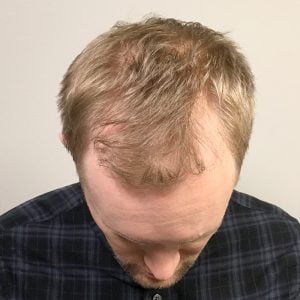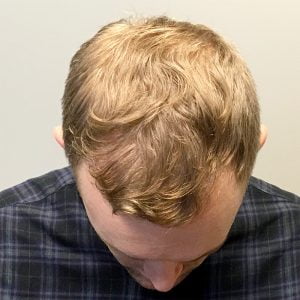What Is a “No-Shave” Hair Transplant?
In a traditional FUE (Follicular Unit Extraction) transplant, the donor area (typically the back of the scalp) is shaved to allow precise follicle removal. A no-shave FUE (or long-hair FUE) avoids this by trimming only the individual follicles being extracted, leaving the surrounding hair untouched. This hides the tiny extraction sites, so your hairstyle remains largely unchanged—no noticeable buzz cut needed. According to research by NCBI, the unshaven method took slightly longer (3.4 minutes vs 2.6 minutes per 50 grafts), but both approaches yielded healthy grafts with similar hair counts. Nonshaven FUE is a helpful technique for patients who wish to avoid shaving the donor area.Unshaven FUE Hair Transplant: Before and After

 Before After
Before After
How Does No-Shave FUE Work?
Let’s understand the entire process of no-shave FUE that generally involves four stages:-
Selective Follicular Trimming
-
Micropunch Extraction
-
Recipient-Site Creation and Graft Placement
-
Post-Operative Concealment
Recovery After No-Shave FUE
Recovery following a no-shave FUE is typically short and quick. Because the surrounding hair masks both donor and recipient sites, many patients can return to desk-based work within 24–48 hours, so long as they refrain from intense physical activity for the first several days. Surgeons usually advise gentle shampooing on the first night, permit light exercise by day 4, and report that most micro-scabs have shed by day 10, signaling the end of acute healing. Overall, patients are back to their regular social and professional routines within one to two weeks, considerably faster than the recovery period associated with fully shaven FUE. Below are some quick recovery tips:- Plan a Weekend Buffer: Even with no-shave FUE, schedule surgery on a Friday and keep weekend plans light.
- Use Gentle Camouflage: Tinted fibers or dry shampoo can reduce shine and blend minor redness.
- Follow After-Care Precisely: Sleeping with your head elevated, avoiding strenuous workouts, and gentle rinsing help grafts settle faster.
- Communicate With Your Stylist: A subtle trim around transplant day can further blend donor and recipient zones.
Benefits and Considerations of No-Shave FUE
To help you decide whether a no-shave FUE is worth the extra time and cost, here’s a quick comparison:Key Advantages
-
Discreet Appearance
-
Shorter Social Downtime
-
Psychological Comfort
Important Practical Considerations
-
Extended Operative Duration
-
Greater Technical Complexity
-
Higher Financial Investment
Who Is an Ideal Candidate?
You are the right candidate if you have:-
Early-to-moderate hair loss
-
Plenty of donor hair
-
High priority on discretion
-
Realistic goals
